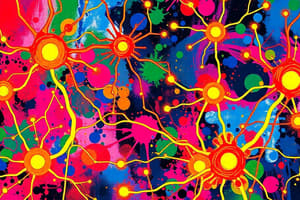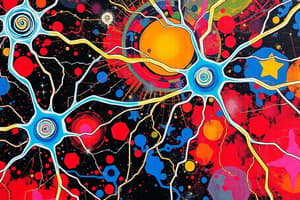Podcast
Questions and Answers
Which of the following statements is NOT true about the spinal cord?
Which of the following statements is NOT true about the spinal cord?
- It is protected by three layers of tissue called meninges.
- It transmits messages from the body to the brain.
- It contains three sections: cervical, thoracic, and lumbar.
- It is responsible for controlling the involuntary functions of the body. (correct)
What is the primary function of the somatic nervous system?
What is the primary function of the somatic nervous system?
- To regulate involuntary body functions like heartbeat and digestion.
- To transmit sensory information from the body to the brain.
- To prepare the body for a fight or flight response.
- To control voluntary movements of the body. (correct)
Which of the following is NOT a layer of the meninges protecting the spinal cord?
Which of the following is NOT a layer of the meninges protecting the spinal cord?
- Dura Mater
- Pia Mater
- Cerebrospinal Fluid (correct)
- Arachnoid Mater
What is the main difference between motor neurons and sensory neurons?
What is the main difference between motor neurons and sensory neurons?
Which part of the nervous system is responsible for the 'fight or flight' response?
Which part of the nervous system is responsible for the 'fight or flight' response?
Which part of the neuron receives messages from other neurons?
Which part of the neuron receives messages from other neurons?
Which of the following is NOT a function of the cerebellum?
Which of the following is NOT a function of the cerebellum?
What is the role of neurotransmitters in the nervous system?
What is the role of neurotransmitters in the nervous system?
Which of the following is an example of an involuntary body function controlled by the nervous system?
Which of the following is an example of an involuntary body function controlled by the nervous system?
What is the main function of the spinal cord?
What is the main function of the spinal cord?
Which part of the brain is responsible for interpreting touch, vision, hearing, speech, and reasoning?
Which part of the brain is responsible for interpreting touch, vision, hearing, speech, and reasoning?
What type of signal is used by neurons to transmit information?
What type of signal is used by neurons to transmit information?
What is the function of the brain stem?
What is the function of the brain stem?
Flashcards
Nervous System
Nervous System
Controls all body functions through neurons transmitting messages.
Neurons
Neurons
Cells that receive and transmit electrochemical signals in the nervous system.
Parts of a Neuron
Parts of a Neuron
Neurons have a cell body, axons, and dendrites for message transmission.
CNS
CNS
Signup and view all the flashcards
Cerebrum
Cerebrum
Signup and view all the flashcards
Cerebellum
Cerebellum
Signup and view all the flashcards
Brain Stem
Brain Stem
Signup and view all the flashcards
Spinal Cord
Spinal Cord
Signup and view all the flashcards
Spinal Cord Sections
Spinal Cord Sections
Signup and view all the flashcards
Meninges Layers
Meninges Layers
Signup and view all the flashcards
Spinal Cord Functions
Spinal Cord Functions
Signup and view all the flashcards
Peripheral Nervous System (PNS)
Peripheral Nervous System (PNS)
Signup and view all the flashcards
Somatic vs Autonomic Nervous System
Somatic vs Autonomic Nervous System
Signup and view all the flashcards
Study Notes
The Nervous System
- The nervous system controls all body functions, including breathing, voluntary and involuntary movements (digestion, heartbeat), and thinking.
- The nervous system is composed of cells called neurons that receive and transmit messages as electrochemical signals.
- The human brain contains 100 billion neurons.
- Neurons have three main parts:
- The cell body, containing the cell nucleus.
- Axons, carrying messages away from the cell body.
- Dendrites, receiving messages from other neurons.
- Bundles of axons are called nerves, located throughout the body.
- The nervous system uses a network of neurons to send messages.
- Neurons employ electrochemical signals for message transmission.
- The signal travels down an axon as an electrical signal, then converts to a chemical signal by neurotransmitters at the synapse.
- The neurotransmitter crosses the synapse, converting back to an electrical signal by the next neuron's dendrite.
The Central Nervous System (CNS)
- The CNS comprises the brain and spinal cord, coordinating bodily functions.
- The Brain:
- The brain is the body's command center, processing information.
- It is responsible for awareness, movements, sensations, thoughts, speech, and memory.
- The three major parts of the brain:
- Cerebrum: The largest part, composed of right and left hemispheres. It is responsible for interpreting touch, vision, hearing, speech, reasoning, emotions, learning, and fine motor control.
- Cerebellum: Located under the cerebrum, coordinating muscle movements, maintaining posture, and balance.
- Brain Stem: Connecting the cerebrum and cerebellum to the spinal cord, managing automatic functions like breathing, heart rate, body temperature, sleep cycles, digestion, sneezing, coughing, vomiting, and swallowing.
- The Spinal Cord:
- A long bundle of nerves and cells extending from the lower brain to the lower back, carrying signals between the brain and body.
- Three sections:
- Cervical (neck)
- Thoracic (chest)
- Lumbar (lower back)
- Protected by three layers of tissue called meninges:
- Pia Mater
- Arachnoid Mater
- Dura Mater
- Vital functions include:
- Carrying signals from the brain: regulating movement and autonomic functions.
- Carrying information to the brain: transmitting sensory information (touch, pressure, pain).
- Reflex responses: enabling the spinal cord to independently control reflexes like the patellar reflex.
The Peripheral Nervous System (PNS)
- The PNS links the CNS to organs, limbs, and skin, carrying sensory and motor information to and from the CNS.
- It regulates involuntary functions like heartbeat and breathing.
- The PNS is divided into two parts:
- The Somatic Nervous System:
- Transmitting sensory information.
- Responsible for voluntary movement.
- Two major types of neurons:
- Motor Neurons: causing physical actions in response to stimuli.
- Sensory Neurons: receiving sensory information and sending it to the brain and spinal cord.
- The Autonomic Nervous System:
- Regulating involuntary body functions (blood flow, heartbeat, digestion, breathing).
- Two branches:
- Sympathetic system: maintaining normal body functions and conserving resources.
- Parasympathetic system: regulating the 'fight-or-flight' response, preparing the body to expend energy in response to perceived threats.
- The Somatic Nervous System:
Studying That Suits You
Use AI to generate personalized quizzes and flashcards to suit your learning preferences.




